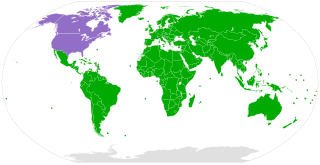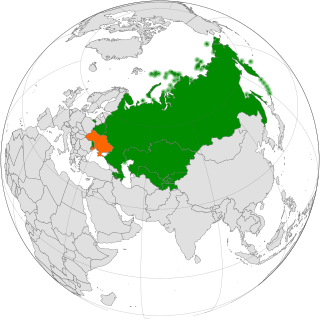
The European Convention on Human Rights is an international convention to protect human rights and political freedoms in Europe. Drafted in 1950 by the then newly formed Council of Europe, the convention entered into force on 3 September 1953. All Council of Europe member states are party to the convention and new members are expected to ratify the convention at the earliest opportunity.
International human rights instruments are the treaties and other international texts that serve as legal sources for international human rights law and the protection of human rights in general. There are many varying types, but most can be classified into two broad categories: declarations, adopted by bodies such as the United Nations General Assembly, which are by nature declaratory, so not legally-binding although they may be politically authoritative and very well-respected soft law;, and often express guiding principles; and conventions that are multi-party treaties that are designed to become legally binding, usually include prescriptive and very specific language, and usually are concluded by a long procedure that frequently requires ratification by each states' legislature. Lesser known are some "recommendations" which are similar to conventions in being multilaterally agreed, yet cannot be ratified, and serve to set common standards. There may also be administrative guidelines that are agreed multilaterally by states, as well as the statutes of tribunals or other institutions. A specific prescription or principle from any of these various international instruments can, over time, attain the status of customary international law whether it is specifically accepted by a state or not, just because it is well-recognized and followed over a sufficiently long time.

The United Nations Convention on the Rights of the Child is an international human rights treaty which sets out the civil, political, economic, social, health and cultural rights of children. The convention defines a child as any human being under the age of eighteen, unless the age of majority is attained earlier under national legislation.

The American Convention on Human Rights, also known as the Pact of San José, is an international human rights instrument. It was adopted by many countries in the Western Hemisphere in San José, Costa Rica, on 22 November 1969. It came into force after the eleventh instrument of ratification was deposited on 18 July 1978.
The Protocol to Prevent, Suppress and Punish Trafficking in Persons, Especially Women and Children is a protocol to the United Nations Convention Against Transnational Organized Crime. It is one of the three Palermo protocols, the others being the Protocol Against the Smuggling of Migrants by Land, Sea and Air and the Protocol Against the Illicit Manufacturing of and Trafficking in Firearms.
The European Convention for the Protection of Pet Animals is a treaty of the Council of Europe to promote the welfare of pet animals and ensure minimum standards for their treatment and protection. The treaty was signed in 1987 and became effective on 1 May 1992, after at least four countries had ratified it. Adherence to the treaty is open and not limited to member countries of the Council of Europe. As of August 2023, it has been ratified by 26 states.

The Convention on Road Signs and Signals, commonly known as the Vienna Convention on Road Signs and Signals, is a multilateral treaty to standardize the signing system for road traffic in use internationally.
The Hague–Visby Rules is a set of international rules for the international carriage of goods by sea. They are a slightly updated version of the original Hague Rules which were drafted in Brussels in 1924.
The Convention for the Protection of Human Rights and Dignity of the Human Being with regard to the Application of Biology and Medicine, otherwise known as the European Convention on Bioethics or the European Bioethics Convention, is an international instrument aiming to prohibit the misuse of innovations in biomedicine and to protect human dignity. The Convention was opened for signature on 4 April 1997 in Oviedo, Spain and is thus otherwise known as the Oviedo Convention. The International treaty is a manifestation of the effort on the part of the Council of Europe to keep pace with developments in the field of biomedicine; it is notably the first multilateral binding instrument entirely devoted to biolaw. The Convention entered into force on 1 December 1999.
Additional Protocol to the Convention on Cybercrime, concerning the criminalisation of acts of a racist and xenophobic nature committed through computer systems is an additional protocol to the Council of Europe Convention on Cybercrime. This additional protocol was the subject of negotiations in late 2001 and early 2002. Final text of this protocol was adopted by the Council of Europe Committee of Ministers on 7 November 2002 under the title "Additional Protocol to the Convention on cybercrime, concerning the criminalisation of acts of a racist and xenophobic nature committed through computer systems, ("Protocol"). The Protocol opened on 28 January 2003 and entry into force is 1 March 2006. As of July 2017, 29 States have ratified the Protocol and a further 13 have signed the Protocol but have not yet followed with ratification.
The General Act for the Pacific Settlement of International Disputes is a multilateral convention concluded in Geneva on September 26, 1928. It went into effect on August 16, 1929 and was registered in League of Nations Treaty Series on the same day. The treaty was ultimately ratified by 22 states. It was subsequently denounced by Spain.

The Maritime Labour Convention (MLC) is an International Labour Organization (ILO) convention, number 186, established in 2006 as the fourth pillar of international maritime law and embodies "all up-to-date standards of existing international maritime labour Conventions and Recommendations, as well as the fundamental principles to be found in other international labour Conventions". The other pillars are the SOLAS, STCW and MARPOL. The treaties applies to all ships entering the harbours of parties to the treaty (port states), as well as to all ships flying the flag of state party (flag states, as of 2021: over 91 per cent).
The Alpine Convention is an international territorial treaty for the sustainable development of the Alps. The objective of the treaty is to protect the natural environment of the Alps while promoting its development. This Framework Convention involves the European Union and eight states. Opened to signature in 1991 and consisting of a Framework Convention, various implementation protocols and declarations, it entered into force in 1995, contributing to reinforce the recognition of special qualities and specific characteristics of the Alps, going beyond national boundaries and seeking international action.

The Treaties of the European Union are a set of international treaties between the European Union (EU) member states which sets out the EU's constitutional basis. They establish the various EU institutions together with their remit, procedures and objectives. The EU can only act within the competences granted to it through these treaties and amendment to the treaties requires the agreement and ratification of every single signatory.
This timeline describes major events in the history of animal welfare and animal rights.

The European Convention for the Protection of Animals kept for Farming Purposes, also known as the Farm Animal Convention, is an animal welfare treaty of the Council of Europe, adopted on 10 March 1976 in Strasbourg, and effective since 10 September 1978.

The European Convention for the Protection of Animals for Slaughter, also known as the Slaughter Convention, is an animal welfare treaty of the Council of Europe, adopted on 10 May 1979 in Strasbourg, and effective since 11 June 1982. It establishes ethical standards pertaining to animal slaughter, such as stunning.

The European Convention for the Protection of Vertebrate Animals used for Experimental and other Scientific Purposes, sometimes simply referred to as the animal experimentation convention or laboratory animals convention, is an animal welfare treaty of the Council of Europe regarding animal testing, adopted on 18 March 1986 in Strasbourg, and effective since 1 January 1991.

Relations between Ukraine and the Commonwealth of Independent States (CIS) are multilateral international relations between a third state and a supranational organization.
![.mw-parser-output .navbar{display:inline;font-size:88%;font-weight:normal}.mw-parser-output .navbar-collapse{float:left;text-align:left}.mw-parser-output .navbar-boxtext{word-spacing:0}.mw-parser-output .navbar ul{display:inline-block;white-space:nowrap;line-height:inherit}.mw-parser-output .navbar-brackets::before{margin-right:-0.125em;content:"[ "}.mw-parser-output .navbar-brackets::after{margin-left:-0.125em;content:" ]"}.mw-parser-output .navbar li{word-spacing:-0.125em}.mw-parser-output .navbar a>span,.mw-parser-output .navbar a>abbr{text-decoration:inherit}.mw-parser-output .navbar-mini abbr{font-variant:small-caps;border-bottom:none;text-decoration:none;cursor:inherit}.mw-parser-output .navbar-ct-full{font-size:114%;margin:0 7em}.mw-parser-output .navbar-ct-mini{font-size:114%;margin:0 4em}
v
t
e
European Convention for the Protection of Animals during International Transport (1968 original)
.mw-parser-output .legend{page-break-inside:avoid;break-inside:avoid-column}.mw-parser-output .legend-color{display:inline-block;min-width:1.25em;height:1.25em;line-height:1.25;margin:1px 0;text-align:center;border:1px solid black;background-color:transparent;color:black}.mw-parser-output .legend-text{}
Signed and ratified
Acceded or succeeded
Only signed
Not signed (CoE member states)
Not signed (non-CoE member states)
Denounced in favour of 2003 revised convention European Convention for the Protection of Animals during International Transport (1968 original) participation map.svg](http://upload.wikimedia.org/wikipedia/commons/thumb/e/ef/European_Convention_for_the_Protection_of_Animals_during_International_Transport_%281968_original%29_participation_map.svg/350px-European_Convention_for_the_Protection_of_Animals_during_International_Transport_%281968_original%29_participation_map.svg.png)










